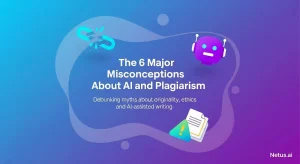Thesis Checker: Expert Guide to Efficiently Validate Your Research

Ashley Merit
Content writer and editor for Netus.AI
Table of Contents
Thesis Checker. The rise of online publications has revolutionized the way writers and researchers share their work, offering a more accessible and cost-effective platform. As the number of published works increase, so does the prevalence of plagiarism, an issue that can tarnish the reputation of authors and hinder future publishing opportunities.
In order to maintain credibility and avoid the negative consequences of plagiarism, it is crucial for researchers to utilize thesis checker tools before sharing their work. These tools can help ensure that writers present original and well-crafted content, thus preserving their professional integrity.
Key Takeaways
- The popularity of online publications has contributed to a rise in plagiarism
- Plagiarism can lead to lasting damage on a researcher’s career and credibility
- Utilizing a thesis checker tool can help writers maintain professional integrity by avoiding plagiarism
What Is Plagiarism in a Thesis?
Plagiarism involves using someone’s writing without proper acknowledgment and presenting it as your own. In a thesis, researchers may feel compelled to incorporate elements of other works to support their arguments. However, to do so ethically, they must put quotes in quotation marks and cite the original author or source.
Failing to use quotation marks correctly, misquoting, or not providing appropriate citation can result in the work being identified as plagiarized, whether intentional or not. Both cases can negatively impact a researcher’s career, as allegations of plagiarism are taken very seriously.
To avoid these issues, researchers should utilize an online plagiarism checker to inspect their thesis for plagiarized content and ensure they have accurately quoted and cited all necessary information.
Common Types of Plagiarism Seen in Thesis Papers
There are various forms of plagiarism that may be found in academic papers, especially in thesis writings. Understanding these types will help researchers create authentic and original content.
- Direct Plagiarism: This occurs when the entire content from a journal or existing work is copied and pasted, with the mistaken belief that it can lead to better grades and impress the readers.
- Mosaic Plagiarism: This type of plagiarism takes place when researchers use parts of their reference works in their thesis, and in order to avoid citations, they modify certain sections with their own words or use synonyms.
- Paraphrasing: This is another prevalent plagiarism issue. Researchers often rephrase parts or entire content from other sources, presenting it as their own work without proper citations but using tools like that can leave you wondering does turnitin detect grammarly.
- Unintentional Plagiarism: This happens when researchers use content from another work but incorrectly quote or cite the source, or forget to use quotation marks. These instances can be considered unintentional plagiarism.
Regardless of intention, all kinds of plagiarism accusations can negatively affect a researcher’s reputation and career. Utilizing plagiarism checker tools can help prevent the production of duplicate content and ensure that their work remains genuine and true.
Consequences of Having a Plagiarized Thesis Paper
Research students aiming for higher studies and successful research careers must prioritize academic integrity in their thesis papers. Presenting original work reflecting one’s intellect and thought process is crucial, as plagiarized content in a thesis can have far-reaching consequences.
Universities and academic institutions employ plagiarism checkers to detect copied content in submitted works. If a student or researcher is caught submitting a plagiarized thesis, they may face several adverse effects on their academic career.
Academic institutions view plagiarism as a breach of integrity. Submitting plagiarized work tarnishes the institution’s reputation, leading to potential loss of international students and negatively impacting rankings. Consequently, these institutions implement strict actions under their educational policies for those found guilty of plagiarism.
In some instances, institutions may assign a failing grade or even expel students with repetitive plagiarism complaints. Researchers, in particular, jeopardize their future opportunities to publish work in reputable journals or webpages if caught submitting plagiarized content. To avoid this, it is essential for students and researchers to utilize thesis checkers.
Additionally, plagiarizing another author’s work can result in legal repercussions. Most countries have stringent laws in place to protect writers’ and artists’ rights to their work. If found guilty, researchers may face imprisonment or financial penalties, severely affecting their career prospects.
In summary, it is imperative for research students to maintain academic integrity and ensure their thesis work is devoid of plagiarized content. This not only safeguards their academic careers but also preserves the respectability of their associated institutions. To accomplish this, researchers and students should utilize thesis checkers and maintain a commitment to producing original, thoughtful work.
How to Produce A Plagiarism-Free Thesis Paper
In order to create a plagiarism-free thesis paper, researchers should focus on developing their own ideas and arguments while properly citing any referenced materials. The following steps can help students ensure the originality of their thesis:
- Keep track of reference materials: Properly quote and cite any supporting materials used in the thesis.
- Use a grammar and spell checker: Identify and correct any grammar mistakes, spelling errors, and syntax errors to ensure the document is error-free before checking for plagiarism.
- Utilize a plagiarism checker: Upload your document to a reliable thesis checking tool that will scan your work and compare it to pre-existing publications, generating a report with the percentage of matched content.
- Address any flagged content: Revise any portions highlighted by the plagiarism checker to ensure your thesis paper is entirely unique and original.
By following these steps, students can confidently submit their academic work knowing it is free of plagiarism and adheres to the highest standards of academic writing.
Frequently Asked Questions
What are the top tools for evaluating thesis quality?
There are various tools available to check the quality of a thesis. Some of the popular tools include SentenceCheckup, ProWritingAid, and Trinka. These tools not only assess grammar and style but also provide suggestions to enhance the overall structure of your thesis.
How do I know if my thesis statement is solid and well-defined?
A strong and clear thesis statement should be concise, arguable, and provide direction for your paper. To verify the strength of your statement, you can use the following checklist:
- Is it a complete sentence?
- Does it convey a specific argument or opinion?
- Is it focused and not too broad?
- Will it engage the reader’s interest?
Additionally, you can use online tools such as the Essay Checker to help assess your thesis statement.
Which platforms offer reliable thesis grammar reviews?
Platforms like Trinka and ProWritingAid are known for their reliable grammar reviews. These tools are designed to identify errors, improve sentence structures, and provide contextual suggestions, ensuring your thesis is of the highest quality.
Are there complimentary tools to evaluate thesis plagiarism?
Yes, there are several tools available for checking plagiarism in a thesis. Some popular free tools include Scribbr’s Plagiarism Checker, which compares your content with millions of web pages and other sources to detect instances of plagiarism.
What are the criteria for evaluating a resilient thesis statement?
A resilient thesis statement should have the following characteristics:
- Conciseness: Summarized in one or two clear sentences
- Arguability: Presents a viewpoint that is subject to debate
- Clarity: Easily understood by the reader
- Direction: Provides a roadmap for your paper
- Engagement: Captures the reader’s interest
How can I identify and rectify common errors in my thesis draft?
To find and correct common errors in your thesis draft, follow these steps:
- Proofread: Read your draft carefully, looking for spelling, grammar, punctuation, and style errors.
- Structure: Analyze the logical flow and organization of ideas.
- Consistency: Ensure consistency in tense, voice, and formatting.
- Formatting: Adhere to specified guidelines, such as font size, margins, and citation style.
- Utilize tools: Use online thesis checking tools, like SentenceCheckup and Trinka, to identify errors and receive suggestions on improvements.
By following these steps and using available online resources, you can effectively polish your thesis draft.

The Role of AI in Content Ideation and Topic Generation | NetusAI
AI’s contribution to content ideation and topic generation AI plays a crucial role in content creation and topic generation. Its effective application significantly reduces preparation

Leveraging AI to conquer writer's block | NetusAI
Overcoming writer’s block with AI Writer’s block affects all writers, new or experienced. Even for the most accomplished writers, this common and frustrating problem presents

AI Overviews: A Comprehensive Guide | NetusAI
A Comprehensive Guide to AI Overviews Google has integrated AI Overviews into its search results as a knowledge panel. This feature acts like an AI

6 Common Misconceptions Regarding AI and Plagiarism | NetusAI
The 6 major misconceptions about AI and plagiarism Regarding AI and plagiarism, numerous myths, misconceptions and assumptions are circulating. Let’s distinguish between fact and fiction.

My writing is repeatedly flagged as AI generated by detection software | NetusAI
AI detectors consistently identify my writing as AI generated Even original, human-written content can face challenges from AI content detection false positives, impacting copywriters and

People Also Ask: Understanding their importance and function in search results
People Also Ask: Understanding their importance and function in search results A People Also Ask (PAA) search result is a zero-click Google response. It presents
